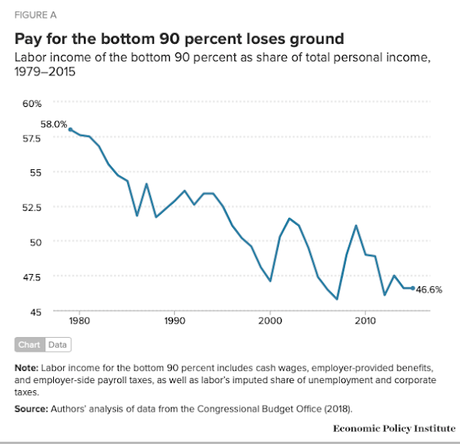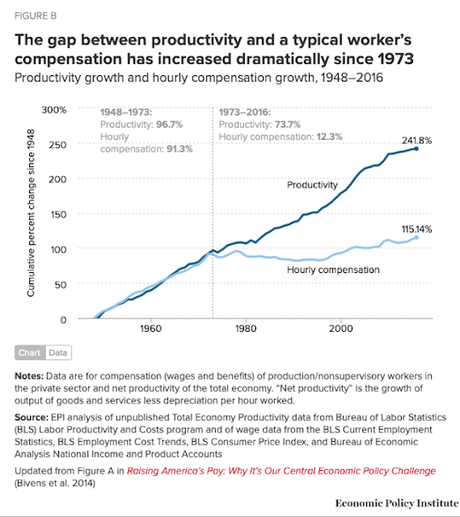
The chart above shows a rather shocking, but unsurprising truth -- that the bottom 90% of Americans have been hurt by Republican policies that tilted the economic policies to favor employers and disempower workers. The following is just a tiny part of an excellent report on this by the Economic Policy Institute (EPI).
Since 1979, the bottom 90 percent of the American workforce has seen their pay shrink radically as a share of total income. Figure A shows total labor compensation for the bottom 90 percent as a share of all market-based income in the American economy. In 1979, this share was 58 percent, but as of 2015 it had shrunk to just under 47 percent. The amount of money this loss represents is staggering; had the 1979 share held constant, the bottom 90 percent of the American workforce would have had roughly $1.35 trillion in additional labor income in 2015, or about $10,800 per household.
What this report finds: Labor markets in capitalist economies are fundamentally tilted against individual workers’ ability to bargain effectively with employers. Policy does not have to be rigged for employers to give them particular clout in labor markets; instead, the very nature of these labor markets gives them clout. In the past, when economic growth was broadly shared across the population, it was because policymakers understood this basic asymmetry and used policy levers to bolster the leverage and bargaining power of workers. Conversely, recent decades’ rise of inequality and anemic wage growth has resulted from a stripping away of these policy bulwarks to workers’ labor market power. Why it matters: Recent research on “monopsony power”—the leverage enjoyed by employers to set their workers’ pay—is a valuable contribution to our understanding of the asymmetry inherent in labor markets. However, “monopsony power” is often a confusing term to even the most savvy economic writers and researchers, and too often it is used only to describe markets that are concentrated (i.e., where there are relatively few employers). Market concentration can indeed suppress workers’ wages, but employer power exists even in markets with lots of employers. If only the narrow conception of “monopsony power” is recognized and policymakers focus only on interventions that target the effect of market concentration (antitrust, for example), then other measures that could more effectively restore the balance of power in labor markets might not get the consideration they should. What can be done about it: There is no one panacea for restoring workers’ leverage and bargaining power in labor markets. Policymakers must be committed to working on every available margin, including restoring genuine full employment as a macroeconomic policy priority; reforming labor law so that workers who want to form a union to collectively bargain to improve their wages and working conditions are able to do so; raising the minimum wage; and strengthening enforcement of labor standards and workplace civil rights laws.


